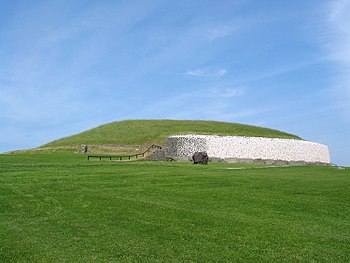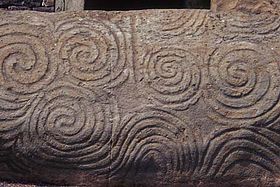Newgrange
From Wikipedia, the free encyclopedia
-
For the Clannad song, see Newgrange (song).
Newgrange (Irish: Dún Fhearghusa) is one of the passage tombs of the Brú na Bóinne complex in County Meath, one of the most famous prehistoric sites in the world and the most famous of all Irish prehistoric sites. Newgrange was built in such a way that at dawn on the shortest day of the year, the winter solstice, a narrow beam of sunlight for a very short time illuminates the floor of the chamber at the end of the long passageway.[1]
Contents |
[edit] History
Newgrange was originally built between c. 3300 and 2900 BC, which means that it is over 5,000 years old. According to Carbon-14 dates,[2] it is more than 500 years older than the Great Pyramid of Giza in Egypt, and predates Stonehenge trilithons by about 1,000 years (although the earliest stages of Stonehenge are roughly contemporary with Newgrange).
In the Neolithic period, Newgrange continued as a focus of some ceremonial activity. New monuments added to the site included a timber circle to the south-east of the main mound and a smaller timber circle to the west. The eastern timber circle consisted of five concentric rows of pits. The outer row contained wooden posts. The next row of pits had clay linings and was used to burn animal remains. The three inner rows of pits were dug to accept the animal remains. Within the circle were post and stake holes associated with Beaker pottery and flint flakes. The western timber circle consisted of two concentric rows of parallel postholes and pits defining a circle 20 m in diameter.
A concentric mound of clay was constructed around the southern and western sides of the mound and covered a structure consisting of two parallel lines of post and ditches that had been partly burnt. A free-standing circle of large stones was constructed encircling the mound. Near the entrance, 17 hearths were used to set fires. These structures at Newgrange are generally contemporary with a number of Henges known from the Boyne Valley, at Newgrange Site A, Newgrange Site O, Dowth Henge and Monknewtown Henge.
[edit] Excavation and restoration
Newgrange lay hidden for over 4,000 years due to mound slippage, until the late 17th century, when men looking for building stone uncovered it, and described it as a cave. Newgrange was excavated and much restored between 1962 and 1975, under the supervision of Professor Michael J. O'Kelly, Department of Archaeology, University College, Cork.[3] It consists of a vast man-made stone and turf mound retained within a circle of 97 large kerbstones topped by a high inward-leaning wall of white quartzite and granite. Most of the stones were sourced locally (within a radius of 20km or so) but the quartzite and granite stones of the facade must have been sourced further afield, most probably in Wicklow and Dundalk Bay respectively.
As part of the restoration process the white quartzite stones and cobbles were fixed into a near-vertical steel-reinforced concrete wall surrounding the entrance of the mound. This restoration is controversial among the archaeological community. Critics of the wall point out that the technology did not exist when the mound was created to fix a retaining wall at this angle. Another theory is that the white quartzite stones formed a plaza on the ground at the entrance. This theory won out at nearby Knowth, where the restorers have laid the quartzite stones out as an "apron" in front of the entrance to the great mound.
[edit] Features
The Newgrange mound is 76m (250ft) across and 12m (40ft) high, and covers an entire acre (0.4ha). Within the mound, a long passage, stretching approximately one third of the length of the mound, leads to a cruciform (cross-shaped) chamber. The passage itself is over 18m (60ft) long. The burial chamber has a corbelled roof which rises steeply upwards to a height of nearly 6m (20 ft). A tribute to its builders, the roof has remained essentially intact and waterproof for over 5,000 years.
Near Newgrange are many other passage tombs, the largest being Knowth, and another significant tomb, Dowth. These tombs are all contemporary with Newgrange and together they and their 37 smaller satellite tombs form the Brú na Bóinne complex.
[edit] Art
Spiral and lozenge motifs engraved on the magnificent entrance slab, "one of the most famous stones in the entire repertory of megalithic art",[4] include a triple spiral motif, found only at Newgrange and repeated along the passage and again inside the chamber, which is reminiscent of the triskelion motif of the Isle of Man, of ancient Sicily and of several passage tombs on the island of Anglesey in North Wales. There are further examples of megalithic art on many other kerbstones at Newgrange (notably Kerbstone 52 and 67). However, the majority of the megalithic art in the Brú na Bóinne complex is located at Newgrange's sister tomb, Knowth.
[edit] Solstice event
Once a year, at the winter solstice, the rising sun shines directly along the long passage into the chamber for about 17 minutes and illuminates the chamber floor.[1] This alignment is too precise to have occurred by chance. Professor M. J. O'Kelly was the first person in modern times to observe this event on December 21, 1967.[5]
The sun enters the passage through a specially contrived opening, known as a roofbox, directly above the main entrance. Although solar alignments are not uncommon among passage graves, Newgrange is one of few to contain the additional roofbox feature (Cairn G at Carrowkeel Megalithic Cemetery is another). The alignment is such that although the roofbox is above the passage entrance, the light hits the floor of the inner chamber.
Today the first light enters about four minutes after sunrise, but calculations based on the precession of the Earth show that 5000 years ago first light would have entered exactly at sunrise.[2] The solar alignment at Newgrange is very precise compared to similar phenomena at other passage graves such as Dowth or Maes Howe in the Orkney islands, off the coast of Scotland.
Current-day visitors to Newgrange are treated to a re-enactment of this event through the use of electric lights situated within the tomb. The finale of a Newgrange tour results in every tour member standing inside the tomb where the tour guide then turns off the lights, and lights the light bulb simulating the sun as it would appear on the winter solstice. Anyone visiting the historic site can experience an approximation of the phenomenon any time of year, and is often the highlight of the tour. A lottery is held annually for "tickets" to be allowed into the tomb to view the actual event. The popularity of this event was the reason a lottery was introduced, and also why the lights were installed.
[edit] Purpose and uses
Newgrange appears to have been used as a tomb. The recesses in the cruciform chamber hold large stone basins into which were placed cremated human remains. During excavation, the remains of five individuals were found. It is speculated that the sun formed an important part of the religious beliefs of the neolithic ("New" Stone Age) people who built it. Formerly the mound was encircled by an outer ring of immense standing stones, of which there are twelve of a possible thirty-seven remaining. However, it seems that the stone circle which encircled Newgrange is not contemporary with the monument itself but was placed there some 1,000 years later in the Bronze Age.
[edit] Newgrange in Irish mythology
According to Irish mythology, Newgrange was one of the sidhe, or fairy-mounds, where the Tuatha Dé Danann lived. It was built by the god Dagda, but his son Oengus later tricked him out of it. It is named for the goddess Boann, the mother of Aengus, who is also credited with the creation of the River Boyne. According to some versions of the story, the hero Cúchulainn was conceived there. However, most of the mythical cycles associated with Newgrange date from the Celtic era of Irish history and mythology. The monument was already in existence for well over 2,000 years before the Celtic era.
[edit] Access to Newgrange
Access to Newgrange is by guided tour only. Tours begin at the Brú na Bóinne Visitor Centre in Donore, Co. Meath, from which visitors are bussed to the site in groups. To experience the phenomenon on the morning of the Winter Solstice from inside Newgrange, one must enter a random drawing at the interpretive center. Roughly 100 people are chosen each year. They are split into groups of five and taken in on the five days around the Solstice in which light does (weather permitting) enter the chamber. In 2006, 27,000 people entered the lottery. The winter solstice of 2007 was watched live via webcast over the two mornings on December 21st and 22nd. It is also shown on RTÉ television.
[edit] References
- ^ a b "The Winter Solstice illumination of Newgrange". http://www.mythicalireland.com/ancientsites/newgrange/illumination.html. Retrieved on 2007-10-12.
- ^ E. Grogan, "Prehistoric and Early Historic Cultural Change at Brugh na Bóinne", Proceedings of the Royal Irish Academy 91C, 1991, pp. 126-132
- ^ M. J. O'Kelly, Newgrange. Archaeology Art and Legend, London: Thames and Hudson, 1982
- ^ Ó Ríordáin, Seán P.; Glyn, Edmund Daniel (1964). New Grange and the Bend of the Boyne. F.A. Praeger. pp. 26. [1]
- ^ "Brú na Bóinne (Newgrange, Knowth and Dowth)". http://www.meath.ie/Tourism/Heritage/Newgrange/. Retrieved on 2007-10-12.
| Wikimedia Commons has media related to: Newgrange |
[edit] See also
[edit] External links
- Newgrange.com
- Information on Newgrange by Meath Tourism
- 360 degree view in Newgrange Central Chamber
- Newgrange info website
- Newgrange information and photos
- Irish passage tombs and other Neolithic monuments
- 101 Facts About Newgrange
- Boyne Valley Portal Website - Information on Newgrange
- Research on Newgrange's possible alignments
- Archaeogeodesy, a Key to Prehistory
- Windows Media recording of the 2007 Winter Solstice event
- Short Video by National Geographic about Newgrange.
- Art and astronomy at Newgrange
- MegalithicIreland.com
|
||||||||||




